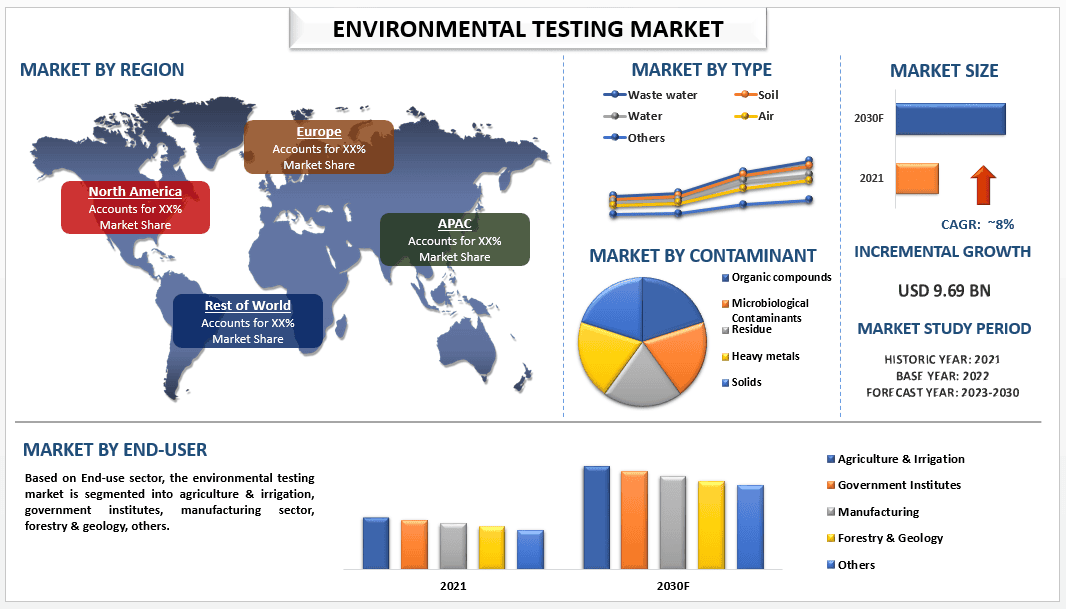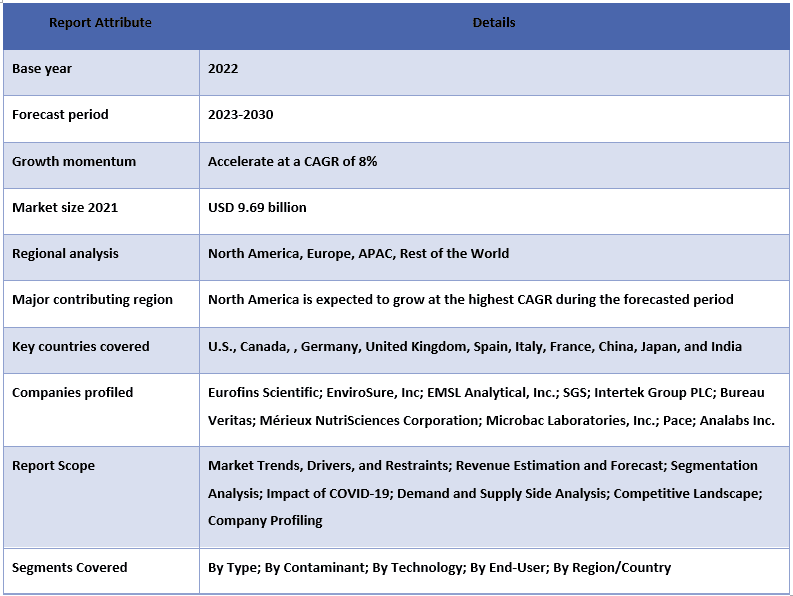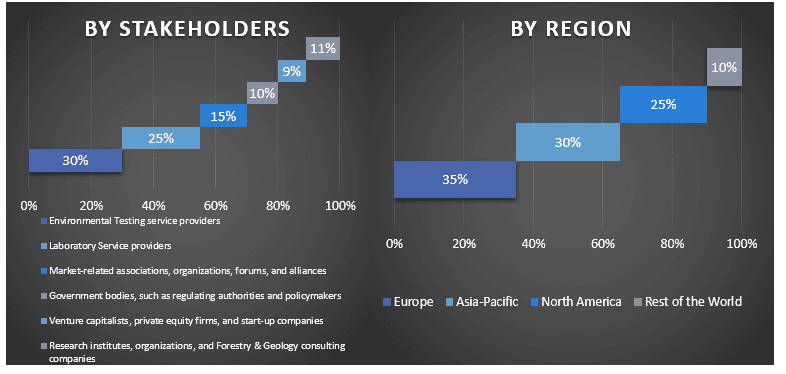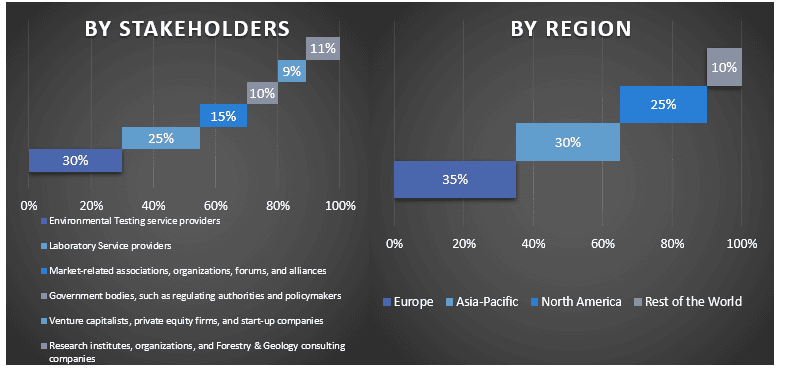Emphasis on Type (Wastewater, Soil, Water, Air, and Others); Contaminant (Organic Compounds, Microbiological Contaminants, Residue, Heavy Metals, and Solids); Technology (Conventional and Rapid); End-User (Agriculture & Irrigation, Government Institutes, Manufacturing, Forestry & Geology, and Other); and Region/Country

Global Environmental Testing Market is expected to grow at a significant rate of 8% during the forecast period. Environmental testing is the process of observing and evaluating how ecological circumstances perform and how they affect living things. Temperature sensitivity, humidity, sun radiation, vibrations, fungi, acoustic measures, and many more characteristics are measured. It enables the forecasting organizations to keep the appropriate levels of the environmental components. The environmental testing lab sector is exceptional, for which the major driver is expected to be governmental regulation, this sometimes acts to inhibit innovation and slow the pace of technological advancement in dealing with environmental problems. Lack of flexibility inherent in governmental regulatory schemes also acts in many cases in removing incentives for environmental testing labs and instrumentation suppliers to explore innovative approaches and improve monitoring capabilities for environmental contaminants. The demand for environmental testing services is growing as people are becoming more aware of the need to pursue sustainable practices. For instance, in October 2023, NKE Group announced the acquisition of Aquaread, the highly reputable manufacturer of water quality measurement and monitoring solutions. This strategic acquisition sets the stage for exciting opportunities and synergies in the environmental instrumentation sector.
Some of the major players operating in the market Eurofins Scientific; EnviroSure, Inc; EnviroSure, Inc; SGS; Intertek Group PLC; Bureau Veritas; Mérieux NutriSciences Corporation; Microbac Laboratories, Inc.; Pace; Analabs Inc. are some of the key players in the market. Several M&A’s along with product launches have been undertaken by these players to facilitate customers with innovative products/technologies.
Insights Presented in the Report
“Amongst type, Wastewater is expected to grow at a significant CAGR”
Based on type, the market is segmented into wastewater, soil, water, air, and others. Wastewater is expected to grow at a significant CAGR. The rise in industrial activity, rising environmental concerns about waste treatment and disposal, regulations on wastewater disposal, rapid urbanization, rise in health standards, demand for clean water, and scarcity of water supply are the main factors driving the growth of this market segment. Wastewater treatment is necessary to protect the environment, the public’s health, and the efficiency of industrial processes.
“Amongst technology, Rapid technology is expected to grow with a robust CAGR during the forecast period”
Based on the technology, the market is bifurcated into conventional and rapid. Rapid technology is expected to grow with a robust CAGR during the forecast period. This is mainly due to the use of advanced analytical methods and techniques that allow for the rapid detection and quantification of environmental contaminants. These methods and techniques are faster and more efficient than traditional methods and can provide real-time results. This makes them particularly useful in situations where quick and accurate results are needed, such as in emergency response situations or in monitoring ongoing environmental contamination. Additionally, rapid technology is often more cost-effective than traditional methods, which can make it more accessible to businesses and individuals.
Environmental Testing Market Report Coverage

“North America is expected to hold the greatest market share in 2022”
North America is expected to hold the greatest market share in 2022. Due to its emphasis on reducing acid rain, greenhouse gas emissions, and other environmental problems including climate change. Additionally, for most environmental issues regulating entities in the US have been driving the growth of the environmental testing market by implementing various environmental protection policies, with numerous initiatives by the authoritative bodies in North American countries being some of the key factors dominating the market. The number of testing laboratories has doubled in the major regions of North America. The government’s establishment of new environmental regulations and transformation of current ones, fuel market demand for environmental testing. During the projection period, demand for the environmental testing market is also driven by favorable government efforts and the requirement for the construction of waste management infrastructure.
Reasons to buy this report:
Customization Options:
The global environmental testing market can further be customized as per the requirement or any other market segment. Besides this, UMI understands that you may have your own business needs, hence feel free to connect with us to get a report that completely suits your requirements.
1. Market Introduction
2. Research Methodology Or Assumption
3. Market Key Insights
4. Executive Summary
5. Impact Of Covid-19 On The Environmental Testing Market
6. Environmental Testing Market Revenue, 2020-2030f
7. Market Insights By Type
8. Market Insights By Contaminant
9. Market Insights By Technology
10. Market Insights By End-user
11. Market Insights By Region
12. Environmental Testing Market Dynamics
13. Environmental Testing Market Opportunities
14. Environmental Testing Market Trends
15. Demand And Supply-side Analysis
16. Strategic Insights
17. Competitive Scenario
18. Company Profiled
19. Disclaimer
Research Methodology for the Environmental Testing Market Analysis (2023-2030)
Analyzing the historical market, estimating the current market, and forecasting the future market of the global environmental testing market were the three major steps undertaken to create and analyze the adoption of environmental testing market in major regions globally. Exhaustive secondary research was conducted to collect the historical market numbers and estimate the current market size. Secondly, to validate these insights, numerous findings and assumptions were taken into consideration. Moreover, exhaustive primary interviews were also conducted, with industry experts across the value chain of the global environmental testing market. Post assumption and validation of market numbers through primary interviews, we employed a top-down/bottom-up approach to forecasting the complete market size. Thereafter, market breakdown and data triangulation methods were adopted to estimate and analyze the market size of segments and sub-segments of the industry pertains to. Detailed methodology is explained below:
Analysis of Historical Market Size
Step 1: In-Depth Study of Secondary Sources:
Detail secondary study was conducted to obtain the historical market size of the Environmental Testing Market through company internal sources such as annual reports & financial statements, performance presentations, press releases, etc., and external sources including journals, news & articles, government publications, competitor publications, sector reports, third-party database, and other credible publications.
Step 2: Market Segmentation:
After obtaining the historical market size of the Environmental Testing Market, we conducted a detailed secondary analysis to gather historical market insights and share for different segments & sub-segments for major regions. Major segments are included in the report as type, contaminant, technology and end user. Further country-level analyses were conducted to evaluate the overall adoption of testing models in that region.
Step 3: Factor Analysis:
After acquiring the historical market size of different segments and sub-segments, we conducted a detailed factor analysis to estimate the current market size of the Environmental Testing Market. Further, we conducted factor analysis using dependent and independent variables such as various type, contaminant, technology and end-user sector of environmental testing market. A thorough analysis was conducted for demand and supply-side scenarios considering top partnerships, mergers and acquisitions, business expansion, and product launches in the environmental testing market sector across the globe.
Current Market Size Estimate & Forecast
Current Market Sizing: Based on actionable insights from the above 3 steps, we arrived at the current market size, key players in the global Environmental Testing Market, and market shares of the segments. All the required percentage shares split, and market breakdowns were determined using the above-mentioned secondary approach and were verified through primary interviews.
Estimation & Forecasting: For market estimation and forecast, weights were assigned to different factors including drivers & trends, restraints, and opportunities available for the stakeholders. After analyzing these factors, relevant forecasting techniques i.e., the top-down/bottom-up approach were applied to arrive at the market forecast for 2030 for different segments and sub-segments across the major markets globally. The research methodology adopted to estimate the market size encompasses:
Market Size and Share Validation
Primary Research: In-depth interviews were conducted with the Key Opinion Leaders (KOLs) including Top Level Executives (CXO/VPs, Sales Head, Marketing Head, Operational Head, Regional Head, Country Head, etc.) across major regions. Primary research findings were then summarized, and statistical analysis was performed to prove the stated hypothesis. Inputs from primary research were consolidated with secondary findings, hence turning information into actionable insights.
Split of Primary Participants in Different Regions

Market Engineering
The data triangulation technique was employed to complete the overall market estimation and to arrive at precise statistical numbers for each segment and sub-segment of the global environmental testing market. Data was split into several segments & sub-segments post studying various parameters and trends in the areas of type, contaminant, technology and end-user in the global environmental testing market.
The main objective of the global pharmaceutical glass packaging market study
The current & future market trends of the global environmental testing market were pinpointed in the study. Investors can gain strategic insights to base their discretion for investments on the qualitative and quantitative analysis performed in the study. Current and future market trends determined the overall attractiveness of the market at a regional level, providing a platform for the industrial participant to exploit the untapped market to benefit from a first-mover advantage. Other quantitative goals of the studies include:

Customers who bought this item also bought